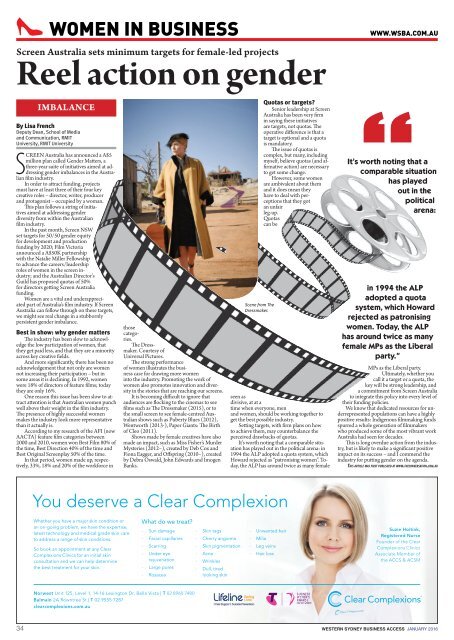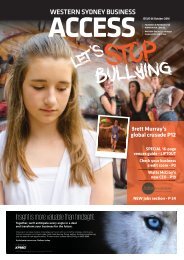ANITA COBBY
WSBA January 2016 Edition
WSBA January 2016 Edition
Create successful ePaper yourself
Turn your PDF publications into a flip-book with our unique Google optimized e-Paper software.
WOMEN IN BUSINESS<br />
WWW.WSBA.COM.AU<br />
Screen Australia sets minimum targets for female-led projects<br />
Reel action on gender<br />
IMBALANCE<br />
By Lisa French<br />
Deputy Dean, School of Media<br />
and Communication, RMIT<br />
University, RMIT University<br />
SCREEN Australia has announced a A$5<br />
million plan called Gender Matters, a<br />
three-year suite of initiatives aimed at addressing<br />
gender imbalances in the Australian<br />
film industry.<br />
In order to attract funding, projects<br />
must have at least three of their four key<br />
creative roles – director, writer, producer<br />
and protagonist – occupied by a woman.<br />
This plan follows a string of initiatives<br />
aimed at addressing gender<br />
diversity from within the Australian<br />
film industry.<br />
In the past month, Screen NSW<br />
set targets for 50/50 gender equity<br />
for development and production<br />
funding by 2020; Film Victoria<br />
announced a A$50K partnership<br />
with the Natalie Miller Fellowship<br />
to advance the careers/leadership<br />
roles of women in the screen industry;<br />
and the Australian Director’s<br />
Guild has proposed quotas of 50%<br />
for directors getting Screen Australia<br />
funding.<br />
Women are a vital and underappreciated<br />
part of Australia’s film industry. If Screen<br />
Australia can follow through on these targets,<br />
we might see real change in a stubbornly<br />
persistent gender imbalance.<br />
Best in show: why gender matters<br />
The industry has been slow to acknowledge<br />
the low participation of women, that<br />
they get paid less, and that they are a minority<br />
across key creative fields.<br />
And more significantly, there has been no<br />
acknowledgement that not only are women<br />
not increasing their participation – but in<br />
some areas it is declining. In 1992, women<br />
were 18% of directors of feature films; today<br />
they are only 16%.<br />
One reason this issue has been slow to attract<br />
attention is that Australian women punch<br />
well above their weight in the film industry.<br />
The presence of highly successful women<br />
makes the industry look more representative<br />
than it actually is.<br />
According to my research of the AFI (now<br />
AACTA) feature film categories between<br />
2000 and 2010, women won Best Film 80% of<br />
the time, Best Direction 40% of the time and<br />
Best Original Screenplay 50% of the time.<br />
In that period, women made up, respectively,<br />
33%, 18% and 20% of the workforce in<br />
those<br />
categories.<br />
The Dressmaker.<br />
Courtesy of<br />
Universal Pictures.<br />
The strong performance<br />
of women illustrates the business<br />
case for drawing more women<br />
into the industry. Promoting the work of<br />
women also promotes innovation and diversity<br />
in the stories that are reaching our screens.<br />
It is becoming difficult to ignore that<br />
audiences are flocking to the cinemas to see<br />
films such as The Dressmaker (2015), or to<br />
the small screen to see female-centred Australian<br />
shows such as Puberty Blues (2012),<br />
Wentworth (2013-), Paper Giants: The Birth<br />
of Cleo (2011).<br />
Shows made by female creatives have also<br />
made an impact, such as Miss Fisher’s Murder<br />
Mysteries (2012–), created by Deb Cox and<br />
Fiona Eagger, and Offspring (2010–), created<br />
by Debra Oswald, John Edwards and Imogen<br />
Banks.<br />
Scene from The<br />
Dressmaker.<br />
Quotas or targets?<br />
Senior leadership at Screen<br />
Australia has been very firm<br />
in saying these initiatives<br />
are targets, not quotas. The<br />
operative difference is that a<br />
target is optional and a quota<br />
is mandatory.<br />
The issue of quotas is<br />
complex, but many, including<br />
myself, believe quotas (and affirmative<br />
action) are necessary<br />
to get some change.<br />
However, some women<br />
are ambivalent about them<br />
and it does mean they<br />
have to deal with perceptions<br />
that they got<br />
an unfair<br />
leg-up.<br />
Quotas<br />
can be<br />
seen as<br />
divisive, at at a<br />
time when everyone, men<br />
and women, should be working together to<br />
get the best possible industry.<br />
Setting targets, with firm plans on how<br />
to achieve them, may counterbalance the<br />
perceived drawbacks of quotas.<br />
It’s worth noting that a comparable situation<br />
has played out in the political arena: in<br />
1994 the ALP adopted a quota system, which<br />
Howard rejected as “patronising women”. Today,<br />
the ALP has around twice as many female<br />
“<br />
It’s worth noting that a<br />
comparable situation<br />
has played<br />
out in the<br />
political<br />
arena:<br />
in 1994 the ALP<br />
adopted a quota<br />
system, which Howard<br />
rejected as patronising<br />
women. Today, the ALP<br />
has around twice as many<br />
female MPs as the Liberal<br />
party.”<br />
MPs as the Liberal party.<br />
Ultimately, whether you<br />
call it a target or a quota, the<br />
key will be strong leadership, and<br />
a commitment from Screen Australia<br />
to integrate this policy into every level of<br />
their funding policies.<br />
We know that dedicated resources for underrepresented<br />
populations can have a highly<br />
positive results: Indigenous filmmaking funds<br />
spurred a whole generation of filmmakers<br />
who produced some of the most vibrant work<br />
Australia had seen for decades.<br />
This is long overdue action from the industry,<br />
but is likely to make a significant positive<br />
impact on its success – and I commend the<br />
industry for putting gender on the agenda.<br />
T HIS ARTICLE WAS FIRST PUBLISHED AT WWW.THECONVERSATION.COM.AU<br />
You deserve a Clear Complexion<br />
Whether you have a major skin condition or<br />
an on-going problem, we have the expertise,<br />
latest technology and medical grade skin care<br />
to address a range of skin conditions.<br />
So book an appointment at any Clear<br />
Complexions Clinics for an initial skin<br />
consultation and we can help determine<br />
the best treatment for your skin.<br />
What do we treat?<br />
· Sun damage<br />
· Facial capillaries<br />
· Scarring<br />
· Under eye<br />
rejuvenation<br />
· Large pores<br />
· Rosacea<br />
· Skin tags<br />
· Cherry angioma<br />
· Skin pigmentation<br />
· Acne<br />
· Wrinkles<br />
· Dull, tired<br />
looking skin<br />
· Unwanted hair<br />
· Milia<br />
· Leg veins<br />
· Hair loss<br />
Suzie Hoitink,<br />
Registered Nurse<br />
Founder of the Clear<br />
Complexions Clinics<br />
Associate Member of<br />
the ACCS & ACSM<br />
Norwest Unit 125, Level 1, 14-16 Lexington Dr, Bella Vista | T 02 8960 7480<br />
Balmain 2A Rowntree St | T 02 9555 7287<br />
clearcomplexions.com.au<br />
34 WESTERN SYDNEY BUSINESS ACCESS JANUARY 2016






